HONDA CIVIC COUPE 1999 Owners Manual
Manufacturer: HONDA, Model Year: 1999, Model line: CIVIC COUPE, Model: HONDA CIVIC COUPE 1999Pages: 269, PDF Size: 2.42 MB
Page 191 of 269
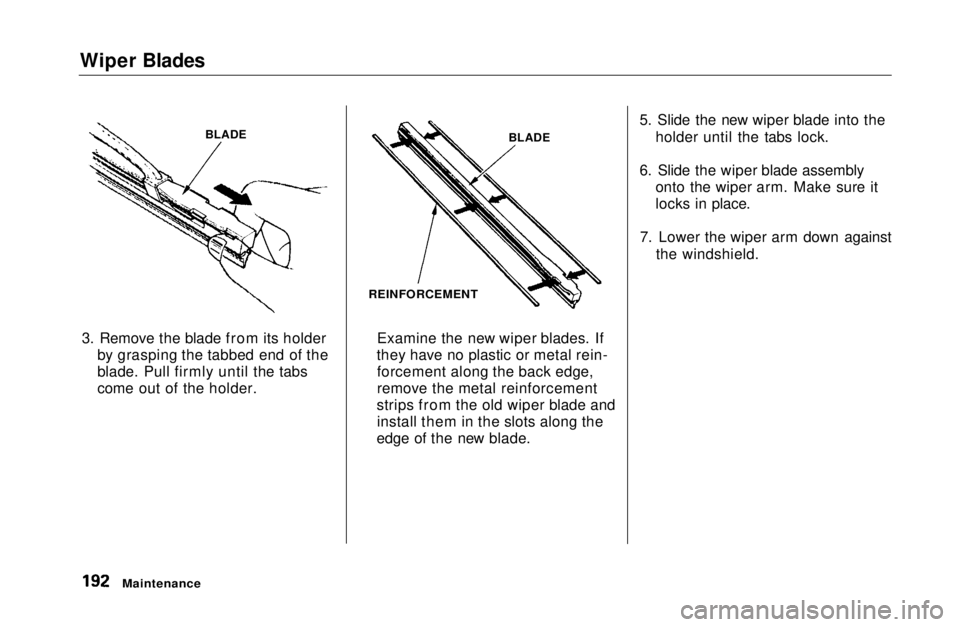
Wiper Blades
3. Remove the blade from its holder by grasping the tabbed end of the
blade. Pull firmly until the tabs
come out of the holder. Examine the new wiper blades. If
they have no plastic or metal rein- forcement along the back edge,
remove the metal reinforcement
strips from the old wiper blade and install them in the slots along the
edge of the new blade. 5. Slide the new wiper blade into the
holder until the tabs lock.
6. Slide the wiper blade assembly onto the wiper arm. Make sure it
locks in place.
7. Lower the wiper arm down against the windshield.
Maintenance
BLADE
BLADE
REINFORCEMENTMain Menu Table of Contents s t
Page 192 of 269
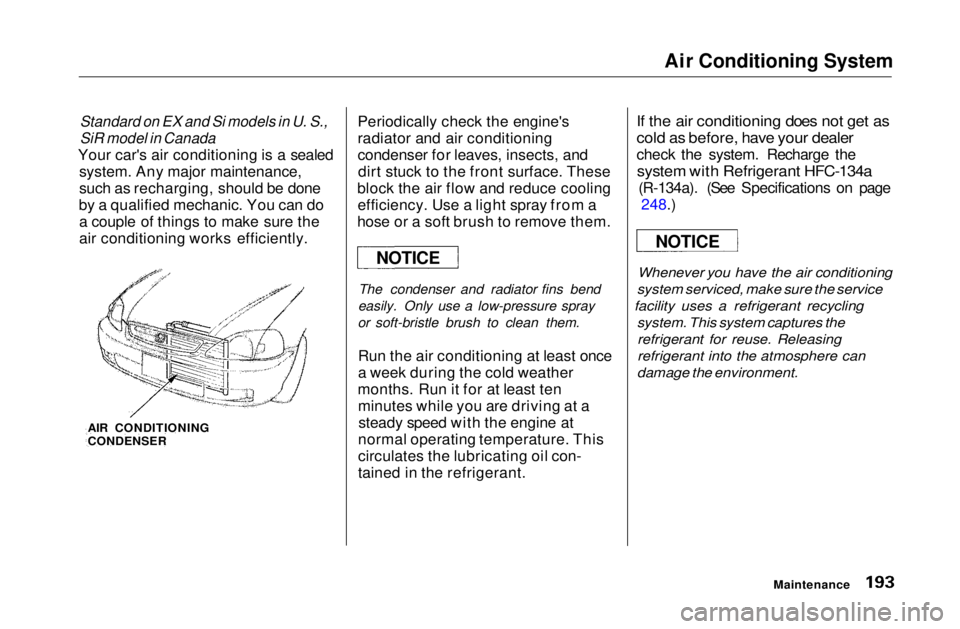
Air Conditioning System
Standard on EX and Si models in U. S.,
SiR model in Canada
Your car's air conditioning is a sealed system. Any major maintenance,
such as recharging, should be done
by a qualified mechanic. You can do a couple of things to make sure the
air conditioning works efficiently. Periodically check the engine's
radiator and air conditioning
condenser for leaves, insects, and
dirt stuck to the front surface. These
block the air flow and reduce cooling efficiency. Use a light spray from a
hose or a soft brush to remove them.
The condenser and radiator fins bend
easily. Only use a low-pressure spray
or soft-bristle brush to clean them.
Run the air conditioning at least once
a week during the cold weather
months. Run it for at least ten minutes while you are driving at asteady speed with the engine at
normal operating temperature. This
circulates the lubricating oil con-
tained in the refrigerant.
If the air conditioning does not get as
cold as before, have your dealer
check the system. Recharge the
system with Refrigerant HFC-134a
(R-134a). (See Specifications on page 248.)
Whenever you have the air conditioning
system serviced, make sure the service
facility uses a refrigerant recycling
system. This system captures the
refrigerant for reuse. Releasing
refrigerant into the atmosphere can
damage the environment.
Maintenance
NOTICE
NOTICE
AIR CONDITIONING
CONDENSERMain Menu Table of Contents s t
Page 193 of 269
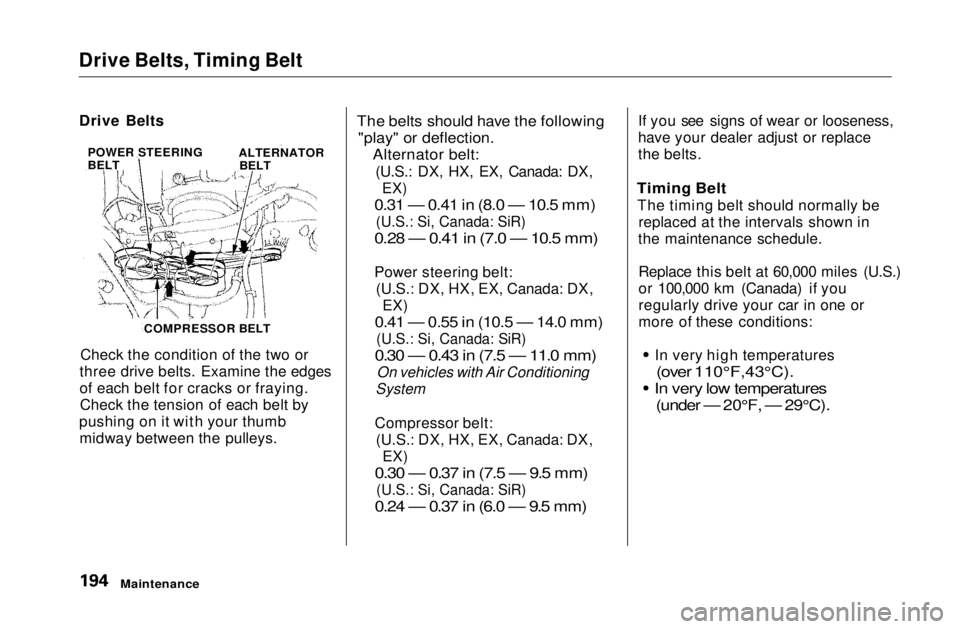
Drive Belts, Timing Belt
Check the condition of the two or
three drive belts. Examine the edges
of each belt for cracks or fraying. Check the tension of each belt by
pushing on it with your thumb midway between the pulleys.
The belts should have the following
"play" or deflection.
Alternator belt:
(U.S.: DX, HX, EX, Canada: DX,
EX)
0.31 — 0.41 in (8.0 — 10.5 mm)
(U.S.: Si, Canada: SiR)
0.28 — 0.41 in (7.0 — 10.5 mm)
Power steering belt: (U.S.: DX, HX, EX, Canada: DX, EX)
0.41 — 0.55 in (10.5 — 14.0 mm)
(U.S.: Si, Canada: SiR)
0.30 — 0.43 in (7.5 — 11.0 mm)
On vehicles with Air Conditioning
System
Compressor belt: (U.S.: DX, HX, EX, Canada: DX,
EX)
0.30 — 0.37 in (7.5 — 9.5 mm)
(U.S.: Si, Canada: SiR)
0.24 — 0.37 in (6.0 — 9.5 mm)
If you see signs of wear or looseness,
have your dealer adjust or replace
the belts.
Timing Belt
The timing belt should normally be replaced at the intervals shown in
the maintenance schedule.
Replace this belt at 60,000 miles (U.S.)
or 100,000 km (Canada) if you
regularly drive your car in one or
more of these conditions:
In very high temperatures
(over 110°F,43°C).
In very low temperatures
(under — 20°F, — 29°C).
Maintenance
Drive Belts
POWER STEERING
BELT ALTERNATOR
BELT
COMPRESSOR BELTMain Menu Table of Contents s t
Page 194 of 269
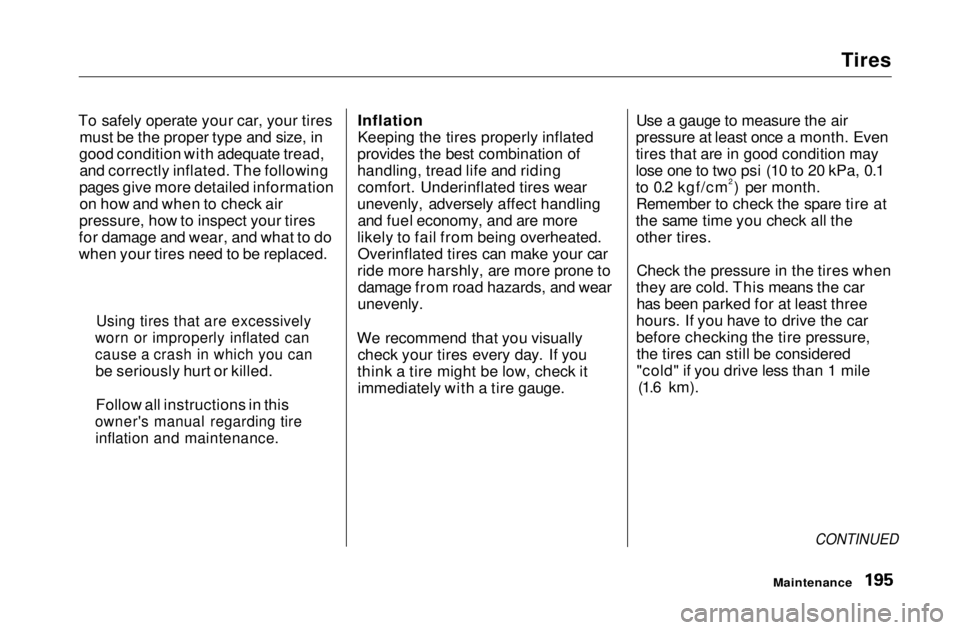
Tires
To safely operate your car, your tires must be the proper type and size, in
good condition with adequate tread, and correctly inflated. The following
pages give more detailed information on how and when to check air
pressure, how to inspect your tires
for damage and wear, and what to do
when your tires need to be replaced.
Inflation
Keeping the tires properly inflated
provides the best combination of
handling, tread life and riding comfort. Underinflated tires wear
unevenly, adversely affect handling and fuel economy, and are more
likely to fail from being overheated. Overinflated tires can make your car
ride more harshly, are more prone to damage from road hazards, and wear
unevenly.
We recommend that you visually check your tires every day. If you
think a tire might be low, check it immediately with a tire gauge. Use a gauge to measure the air
pressure at least once a month. Even
tires that are in good condition may
lose one to two psi (10 to 20 kPa, 0.1
to 0.2 kgf/cm2) per month. Remember to check the spare tire at
the same time you check all the other tires.
Check the pressure in the tires when
they are cold. This means the car has been parked for at least three
hours. If you have to drive the car
before checking the tire pressure, the tires can still be considered
"cold" if you drive less than 1 mile (1.6 km).
CONTINUED
Maintenance
Using tires that are excessively
worn or improperly inflated can
cause a crash in which you can
be seriously hurt or killed.
Follow all instructions in this
owner's manual regarding tire
inflation and maintenance.Main Menu Table of Contents s t
Page 195 of 269
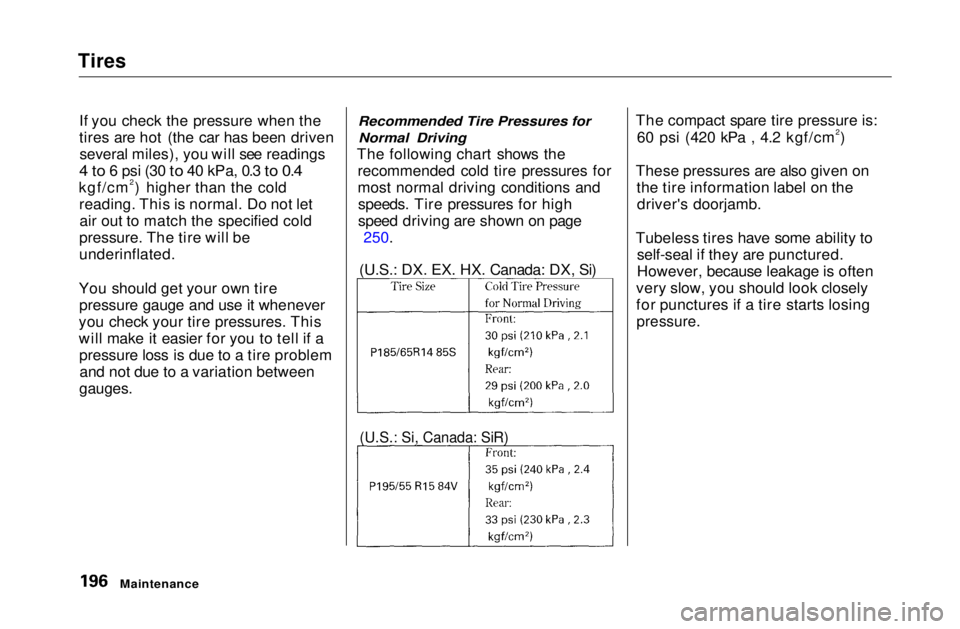
Tires
If you check the pressure when the
tires are hot (the car has been drivenseveral miles), you will see readings
4 to
6 psi (30
to
40 kPa, 0.3
to 0.4
kgf/cm2) higher than the cold reading. This is normal. Do not letair out to match the specified cold
pressure. The tire will be
underinflated.
You should get your own tire pressure gauge and use it whenever
you check your tire pressures. This
will make it easier for you to tell if a pressure loss is due to a tire problemand not due to a variation between
gauges.
Recommended Tire Pressures for
Normal Driving
The following chart shows the recommended cold tire pressures for
most normal driving conditions andspeeds. Tire pressures for high
speed driving are shown on page
250.
(U.S.: DX. EX. HX. Canada: DX, Si)
(U.S.: Si, Canada: SiR)
The compact spare tire pressure is:
60 psi (420 kPa , 4.2 kgf/cm2)
These pressures are also given on the tire information label on thedriver's doorjamb.
Tubeless tires have some ability to self-seal if they are punctured.
However, because leakage is often
very slow, you should look closely
for punctures if a tire starts losing
pressure.
MaintenanceMain Menu Table of Contents s t
Page 196 of 269
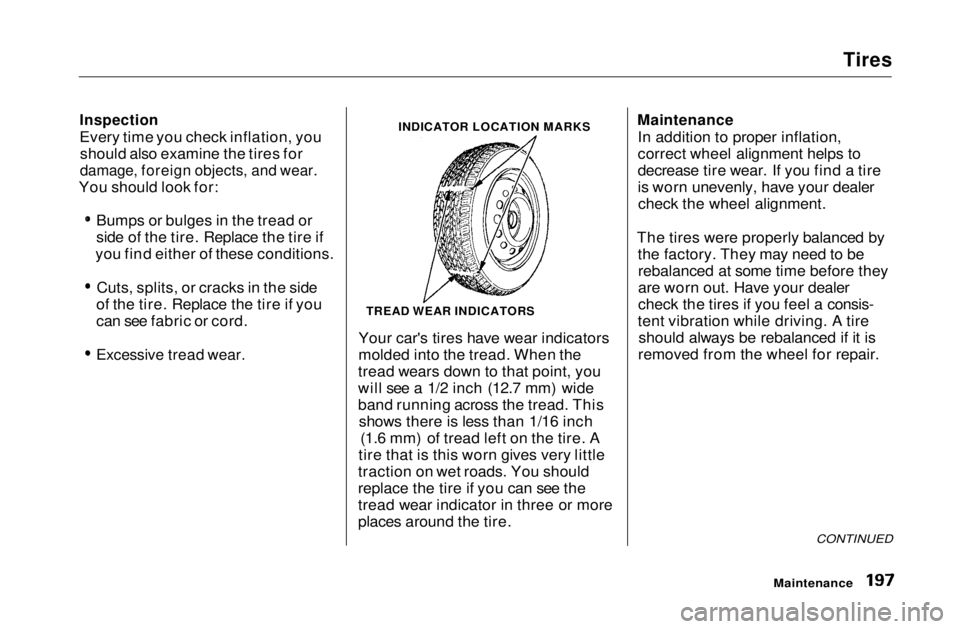
Tires
Inspection
Every time you check inflation, you should also examine the tires for
damage, foreign objects, and wear.
You should look for:
Bumps or bulges in the tread or
side of the tire. Replace the tire if
you find either of these conditions.
Cuts, splits, or cracks in the side
of the tire. Replace the tire if you
can see fabric or cord.
Excessive tread wear.
Your car's tires have wear indicators
molded into the tread. When the
tread wears down to that point, you
will see a 1/2 inch (12.7 mm) wide
band running across the tread. This shows there is less than 1/16 inch (1.6 mm) of tread left on the tire. A
tire that is this worn gives very little
traction on wet roads. You should
replace the tire if you can see the
tread wear indicator in three or more
places around the tire.
Maintenance
In addition to proper inflation,
correct wheel alignment helps to
decrease tire wear. If you find a tire
is worn unevenly, have your dealercheck the wheel alignment.
The tires were properly balanced by the factory. They may need to berebalanced at some time before they
are worn out. Have your dealer
check the tires if you feel a consis-
tent vibration while driving. A tire should always be rebalanced if it is
removed from the wheel for repair.
CONTINUED
Maintenance
INDICATOR LOCATION MARKS
TREAD WEAR INDICATORSMain Menu Table of Contents s t
Page 197 of 269
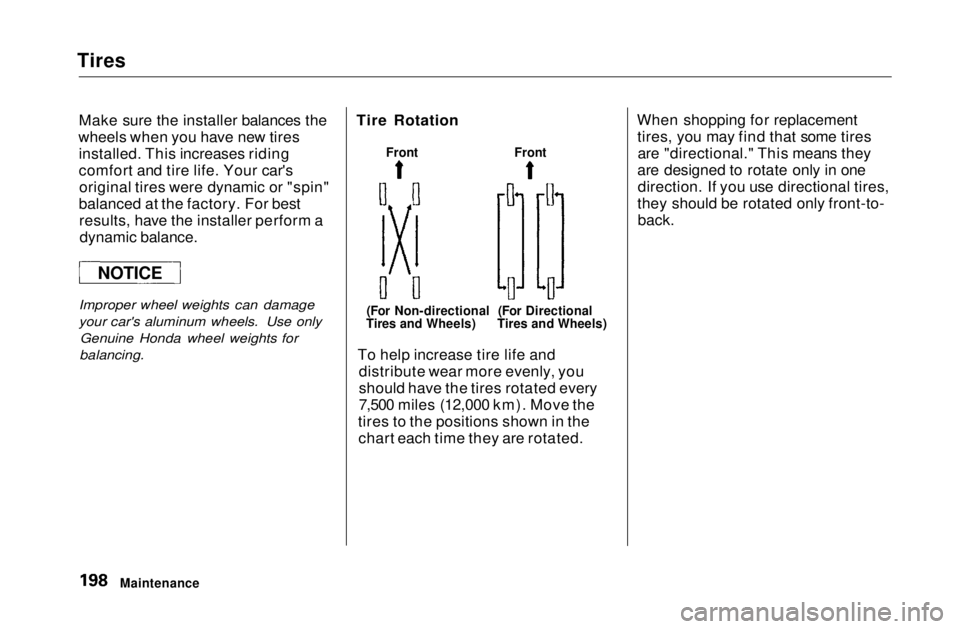
Tires
Make sure the installer balances the
wheels when you have new tires installed. This increases riding
comfort and tire life. Your car'soriginal tires were dynamic or "spin"
balanced at the factory. For best results, have the installer perform adynamic balance.
Improper wheel weights can damage
your car's aluminum wheels. Use only Genuine Honda wheel weights for
balancing.
Tire Rotation
To help increase tire life anddistribute wear more evenly, you
should have the tires rotated every
7,500 miles (12,000 km). Move the
tires to the positions shown in the chart each time they are rotated. When shopping for replacement
tires, you may find that some tiresare "directional." This means they
are designed to rotate only in one direction. If you use directional tires,
they should be rotated only front-to- back.
Maintenance
NOTICE
Front
Front
(For Non-directional
Tires and Wheels) (For Directional
Tires and Wheels)Main Menu Table of Contents s t
Page 198 of 269
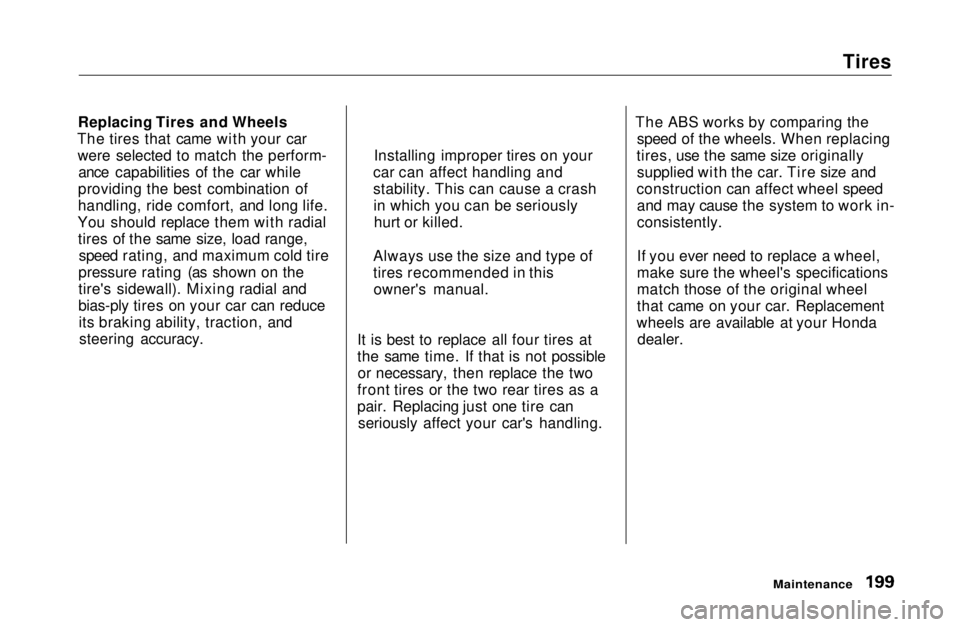
Tires
Replacing Tires and Wheels
The tires that came with your car were selected to match the perform- ance capabilities of the car while
providing the best combination of
handling, ride comfort, and long life.
You should replace them with radial tires of the same size, load range, speed rating, and maximum cold tire
pressure rating (as shown on the
tire's sidewall). Mixing radial and
bias-ply tires on your car can reduce its braking ability, traction, andsteering accuracy. It is best to replace all four tires at
the same time. If that is not possible
or necessary, then replace the two
front tires or the two rear tires as a
pair. Replacing just one tire can seriously affect your car's handling. The ABS works by comparing the
speed of the wheels. When replacing
tires, use the same size originally supplied with the car. Tire size and
construction can affect wheel speed and may cause the system to work in-
consistently.
If you ever need to replace a wheel,
make sure the wheel's specifications
match those of the original wheel
that came on your car. Replacement
wheels are available at your Honda dealer.
Maintenance
Installing improper tires on your
car can affect handling and
stability. This can cause a crash in which you can be seriouslyhurt or killed.
Always use the size and type of
tires recommended in this owner's manual.Main Menu Table of Contents s t
Page 199 of 269
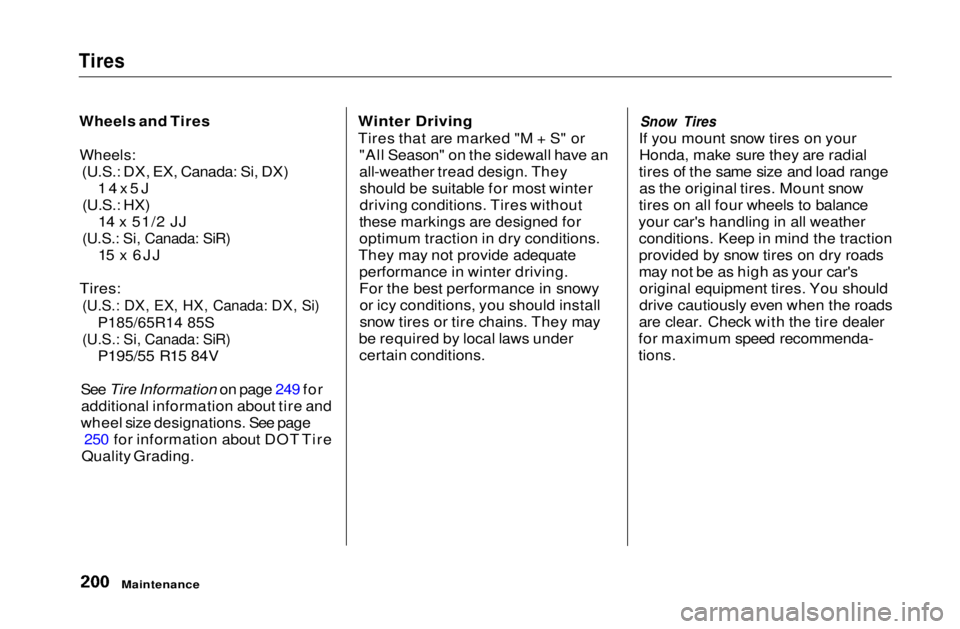
Tires
Wheels and Tires
Wheels:
(U.S.: DX, EX, Canada: Si, DX) 14x5J
(U.S.: HX) 14 x 51/2 JJ
(U.S.: Si, Canada: SiR)
15 x 6JJ
Tires:
(U.S.: DX, EX, HX, Canada: DX, Si)
P185/65R14 85S
(U.S.: Si, Canada: SiR)
P195/55 R15 84V
See Tire Information on page 249 for additional information about tire and
wheel size designations. See page 250 for information about DOT Tire
Quality Grading.
Winter Driving
Tires that are marked "M + S" or
"All Season" on the sidewall have an
all-weather tread design. Theyshould be suitable for most winter
driving conditions. Tires without
these markings are designed for
optimum traction in dry conditions.
They may not provide adequate performance in winter driving.
For the best performance in snowyor icy conditions, you should install
snow tires or tire chains. They may
be required by local laws under certain conditions.
Snow Tires
If you mount snow tires on your Honda, make sure they are radial
tires of the same size and load range as the original tires. Mount snow
tires on all four wheels to balance
your car's handling in all weather conditions. Keep in mind the traction
provided by snow tires on dry roads
may not be as high as your car'soriginal equipment tires. You should
drive cautiously even when the roads
are clear. Check with the tire dealer
for maximum speed recommenda-
tions.
MaintenanceMain Menu Table of Contents s t
Page 200 of 269
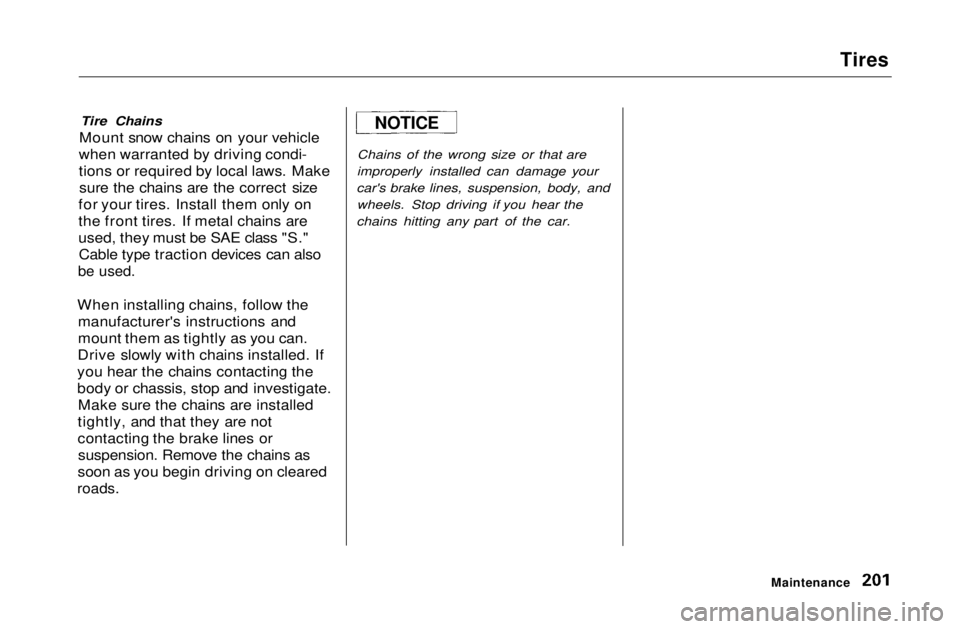
Tires
Tire Chains
Mount snow chains on your vehicle
when warranted by driving condi-
tions or required by local laws. Make sure the chains are the correct size
for your tires. Install them only on
the front tires. If metal chains are
used, they must be SAE class "S." Cable type traction devices can also
be used.
When installing chains, follow the manufacturer's instructions and
mount them as tightly as you can.
Drive slowly with chains installed. If
you hear the chains contacting the
body or chassis, stop and investigate. Make sure the chains are installed
tightly, and that they are not
contacting the brake lines or suspension. Remove the chains as
soon as you begin driving on cleared
roads.
Chains of the wrong size or that are
improperly installed can damage your
car's brake lines, suspension, body, and wheels. Stop driving if you hear the
chains hitting any part of the car.
Maintenance
NOTICEMain Menu Table of Contents s t